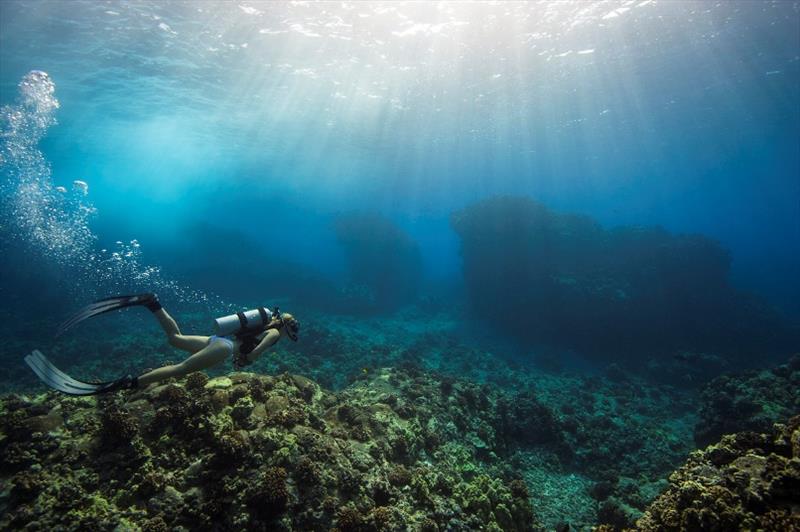
Tracking and managing predicted massive coral bleaching in Hawaii
by NOAA Fisheries 13 Sep 2019 13:14 UTC

A woman scuba dives atop a coral reef in the tropical waters of Kona, Hawaii © Christine Shepard
Satellite data from the NOAA Coral Reef Watch program indicate coral reefs in the Northwestern Hawaiian Islands are experiencing a major bleaching event.
The National Coral Reef Monitoring Program surveyed the Papahanaumokuakea Marine National Monument and found extensive bleaching. At Kure Atoll, the northernmost atoll in the archipelago, almost 100 percent of shallow-water corals (less than 15 feet deep) are bleached. Severe coral bleaching is predicted to extend across the Hawaiian Archipelago, including the populated main Hawaiian Islands.
Coral bleaching occurs due to stressors including warmer water temperatures. When stressed, the coral expels algae that live in their tissues, making the coral lose its color and turn completely white.
"Ocean temperatures are extremely warm right now across the main Hawaiian Islands," said NOAA scientist Jamison Gove. "They're up to 3.5 degreesF warmer than what we typically experience this time of year. If the ocean continues to warm even further as predicted, we are likely to witness a repeat of unprecedented bleaching events in 2014 and 2015."
When the rotational speed of ocean currents in the Subtropical Gyre is slowed, waters from the northeast take more time to reach Hawai'i and, therefore, arrive warmer than normal. These are the conditions that NOAA scientists are currently seeing around Hawai'i.
Researchers at Arizona State University created and maintain the Hawai'i coral bleaching tracker, which is helping to identify bleaching areas. Scientists and conservation managers urge visitors and the community in Hawai'i to report any sightings of coral bleaching through this website. Arizona State University and NOAA scientists are using this and NOAA data to provide weekly reports to the state to track bleaching. These reports are publicly available on the website.
Sometimes corals are able to recover from bleaching. However, they can die if stressors, such as warmer ocean temperatures, continue. Studies have shown that if local stressors are reduced before, during, and after bleaching events, corals are more likely to recover. Local stressors include human impacts, such as unintentionally knocking over coral while snorkeling or diving, boat anchors hitting coral, unsustainable fishing practices, and pollution from nearby watersheds.
The State of Hawai'i's Department of Land and Natural Resources will introduce an initiative in October aimed at tour operators to inform their guests about good reef practices. Numerous operators, like FairWind Big Island Ocean Guides on Hawai'i Island, are already educating people on their boats. They ask them not to stand on, sit on, or touch the reef and to use reef-safe sunscreen products.
Here are ways residents and visitors can help keep the reefs healthy:
- Avoid touching corals or coral reefs while diving, snorkeling, or swimming.
- Refrain from standing or resting on corals.
- Use reef-safe sunscreens.
- Boaters should use mooring buoys or anchor only in sandy areas.
- Keep anchor chains off the reef.
- Take extra precautions to prevent other potential contaminants from getting into the ocean.
Bleaching impacts corals and communities
Corals are not just important for marine life. They are also connected to cultural, recreational, and economic components of Hawai'i's social-ecological system. Reefs are often called the rainforests of the ocean. They are home to a large number and variety of species and are very productive in relation to their small physical footprint.
Reefs protect coastlines by serving as breakwaters—reducing a wave's energy by up to 97 percent. They minimize the impacts of hurricanes and other tropical storms. They bring in tourists, which supports the local economy and creates sustainable jobs. They provide food for many coastal communities. Some medicines are also derived from coral species and other marine life in reefs. Importantly, they are also a significant part of communities' culture and well-being. Studies have shown that people who connect and interact with nature are overall happier and healthier. While bleaching is devastating to marine life, it is also devastating to local communities. Worldwide, more than 500 million people depend on coral reefs for food, income, coastal protection, and more.
NOAA scientists are using NOAA's Integrated Ecosystem Assessment approach to better incorporate all of these ecosystem components into the management process in Hawai'i. This approach integrates all components of an ecosystem, including humans, into the decision-making process. That way, managers can balance trade-offs and determine what is more likely to achieve their desired goals.
Scientists will continue to monitor this event and consider these many ecosystem components during this time of unprecedented warming and potential bleaching.